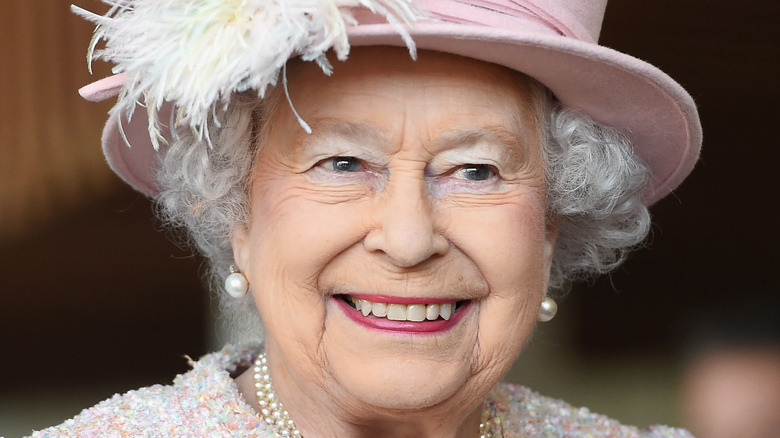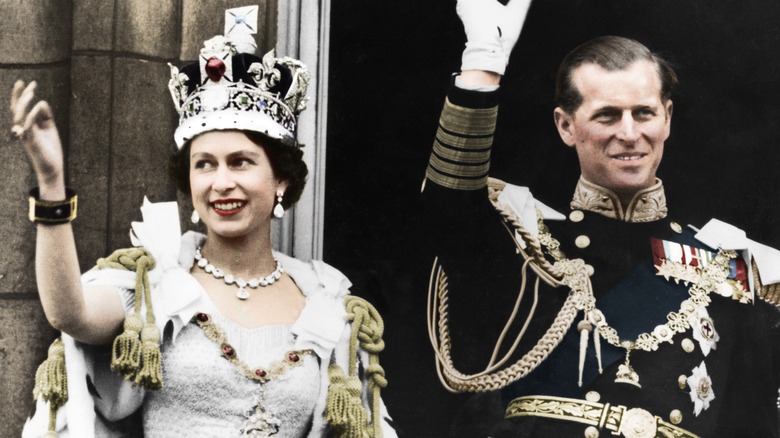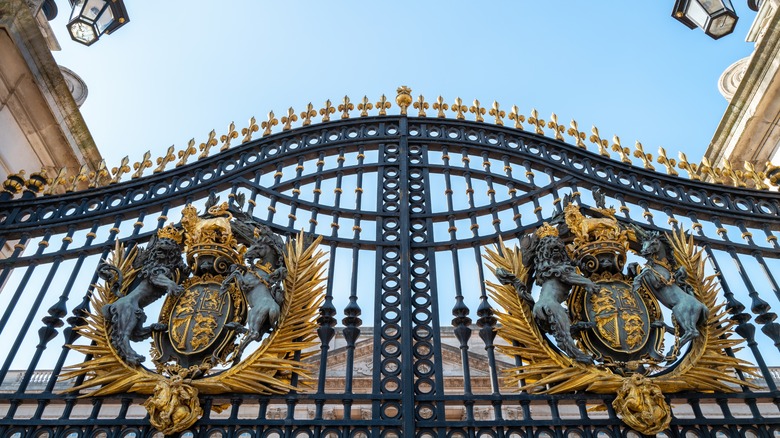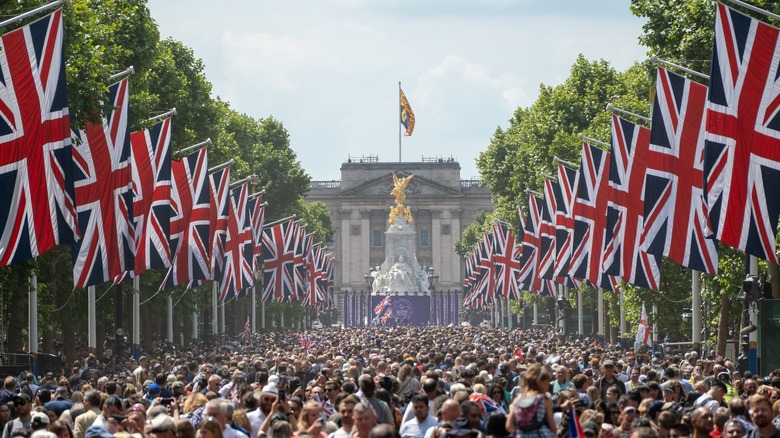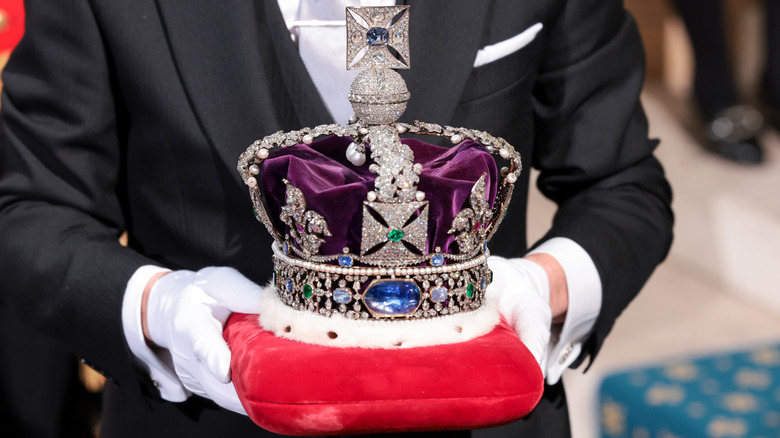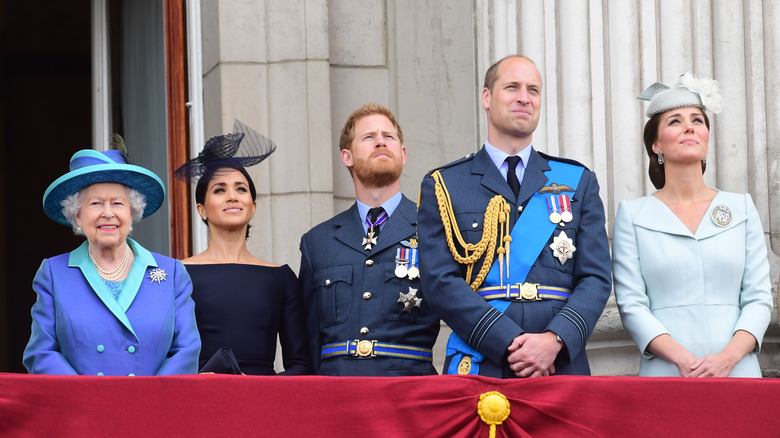What Was Queen Elizabeth II's Net Worth When She Died?
The world was stunned and saddened when it heard that Queen Elizabeth II, the longest-ruling monarch in English history, died on September 8, 2022. She was 96. "The Queen died peacefully at Balmoral this afternoon," posted the royal family on Twitter. "The King and The Queen Consort will remain at Balmoral this evening and will return to London tomorrow."
In the wake of the Queen's passing, citizens of the UK and the globe alike turn to questions about her life, her legacy, and more. One question asked of Elizabeth II, and often royalty in general, is the very simple, "How much money do they have?" When getting to the bottom of that kind of question, we can't merely check the balance of a personal savings account. The queen was tied to a lineage of money and power stretching back to the Norman Conquest of England in 1066 CE, which over the centuries has accrued estates and their upkeep, tons of staff, public and private funds, separate business that manage those funds, various sources of income, assets, and investments, etc., as the BBC outlines.
The short answer is: Elizabeth II's personal wealth equaled about £370 million (about $440 million). As The Times ranks it, this put her at less than half the wealth of "Harry Potter" author J.K. Rowling, over double that of singer Adele, and about the same as Victoria and David Beckham. The queen herself wasn't even in the top 250 wealthiest people in the UK. The long answer is much, much more complicated.
Inheritance and marriage
Queen Elizabeth II's personal fortune of £370 million (per The Times) was just that: personal. To really understand her net worth, we've got to dig down into the difference between her private wealth and what she temporarily "owned," or was allocated, during her 70+-year tenure as head of the British Crown.
Elizabeth II's fortune began as an inheritance from Elizabeth I, her own mother and "Queen Mother." As the BBC reports, the Queen Mother left her entire £70 million estate to Elizabeth II, which included Buckingham Palace and everything it contained. We're not talking about vaults of gold or stacks of £50 notes, but the property itself and a lot of valuable artwork and possessions like paintings, porcelain ware, a Faberge egg collection, jewelry, horses, and so on. It also included a passing on of investments, subject to a "sovereign to sovereign" tax clause that prevented taxation above £250,000. Be aware, however, that Buckingham Palace is "the sovereign's public estate" that belongs to the Crown, not Elizabeth herself (via Marie Claire).
When Queen Elizabeth married Prince Philip in 1947, Prince Philip — born from Greek and Danish royalty — brought his own inheritances and wealth with him, which were added to the Crown's. And like other members of the royal family, Prince Philip received an annual annuity "to meet the expenses of carrying out his public duties in support of the Queen," as Insider quotes. His estate, as Cosmopolitan quotes, was worth about £10 million pounds.
Property around the kingdom
A big chunk of Queen Elizabeth II's personal wealth came from property around the UK. As Marie Claire cites, the queen personally owned Balmoral Castle (about £120 million) in Aberdeenshire, Scotland, and Sandringham House (about £55 million) in Norfolk, England. That's close to half of the queen's entire fortune. As mentioned, Buckingham Palace and its contents belong to the British Crown, not Elizabeth II herself. As Good Housekeeping reports, those are worth just under £1.2 billion.
The queen also received income from the Duchy of Lancaster, a set of lands in the UK that date back to 1399. This means that in addition to being queen, Elizabeth II was also the Duke (or perhaps Duchess) of Lancaster. Her Duchy included an expanse of properties throughout the UK split up into eight small units called "Surveys" — five rural surveys in Cheshire, Lancashire, Staffordshire, Yorkshire, and Southern counties equaling about 18,000 hectares (about 70 square miles), the retail and commercial Urban Survey in London, the agricultural expanse of Foreshore Survey in the north equaling 36,000 hectares (about 140 square miles), and a set of limestone and sandstone quarries in the Minerals Survey from South Wales to North Yorkshire.
The title "Duke of Lancaster" and its properties pass from monarch to monarch, as Good Housekeeping explains, which means that Elizabeth II didn't own them. She did, however, receive the revenue from them, an amount dubbed the "Privy Purse" (pocket change, basically). In 2017, this amount equaled about £21 million.
Taxes from the masses
And so we come to perhaps the most complicated part of the queen's wealth and income: taxes. The quueen didn't just get a cut of annual taxes from UK citizenry. A portion of taxes is funneled to a separate business — the Crown Estate — that manages the royal family's properties and individual allowances. As the BBC explains, the Crown Estate dates back to the Norman Invasion in 1066, much like the British monarchy itself. In 1760, King George III kicked off the current Crown Estate system, which doles out his wealth to his successors bit by bit. This system, known as the Public List, got revised in 2010 to its current scheme, the Sovereign Grant.
In a nutshell, the Crown Estate passes its profits along to the UK's Ministry of Finance, which calculates a percentage to kick back to the royal family, including the queen. This amount, the Sovereign Grant, is disbursed between family members. The rest goes to the national treasury. And to complicate matters further, it's the Crown who owns the Crown Estate. Typically, the Sovereign Grant pays out between 15 and 25%, but got a steady boost to 25% starting in 2017 to help fund a 10-year long, £369 million refurbishment of Buckingham Palace. As Cosmopolitan reports, Crown Estate profits in 2020 equaled £475 million. This means that £86.3 million went back to the royal family.
For the curious, the Crown Estate releases all of its financial information in downloadable form online.
Literal treasure troves
The queen also owned, for lack of a more regal term, a bunch of pricey knickknacks. Some of them related to her personal wealth, while others to the general wealth of the British Crown.
Top of the collectibles list was — believe it or not — the queen's personal stamp collection, the Royal Philatelic Collection. As The Sunday Times reports, the collection was established in 1864 and is worth a whopping £100 million. When combined with her personal properties, Balmoral Castle and Sandringham House, this equals £275 million, or about three-quarters of the Queen's individual fortune. By all accounts, this was not a casual hobby for Elizabeth II. She added to the collection regularly, and even showed it off to visiting heads of state.
We've mentioned the artwork and valuables at Buckingham Palace – paintings, a Faberge egg collection, horses, and so on. These valuables are part of the Royal Collection, and as the BBC says, some of them were passed along to Elizabeth II from the Queen Mother. The Royal Collection — a trust set aside for the general public — also contains "photographs, portraits, tapestries, gems, and jewels" including brooches, tiaras, and more, as Good Housekeeping reports. Collectively, these are worth about £100 million. While we're sure the queen had personal jewelry, there's no record of its worth.
The queen also had a private investment portfolio of "blue chip" stocks, as Cosmopolitan states: reliable, non-volatile shares with well-established companies.
Passing on the thrift and wealth
Some personal, frugal habits helped the queen hold on to her wealth. Granted, when ceremony was called for, little expense was spared. Her 2022 diamond jubilee celebration cost taxpayers a whopping £28 million, as Fortune describes. However, estimates stated that it would yield a £3.47 billion boost to the economy, largely in retail, food, and drink. On a smaller, but still massive scale, the royal family spent £1.3 to £4.5 million on private transportation from 2021 to 2022. One such trip by the queen, to the annual G7 international leader's conference, cost £31,796.
That being said, CNBC reports lots of royal cost-cutting between all family members. The queen sometimes took regular, commercial trains, instructed house staff to keep lights off in unused rooms, reused older clothing, and often preferred leftovers like shepherd's pie for dinner. Her grandchildren, Princes William and Harry, took regular flights, also reused older clothing, and bought furniture from IKEA.
Now that Queen Elizabeth II has died, some wonder not only about her wealth, but who will inherit it. As Express reports, the queen intended for her fortune to pass to her son, Prince Charles. This wealth is subject to the same sovereign-to-sovereign tax clause that protected Elizabeth II's inheritance when the Queen Mother died. The other elements of the queen's fortune that belong to the Crown, like the Duchy of Lancaster, pass to King Charles, as well.
